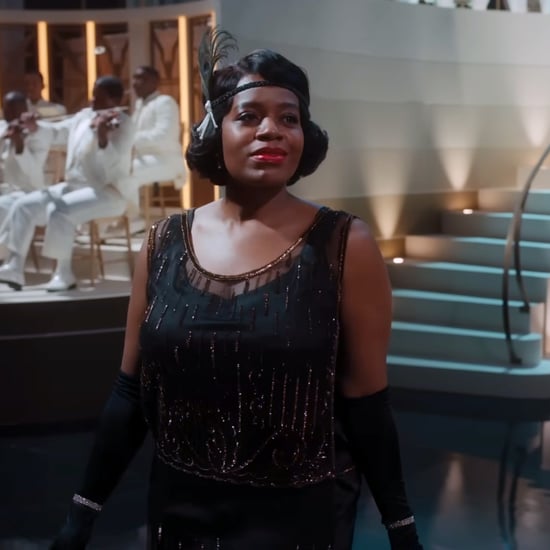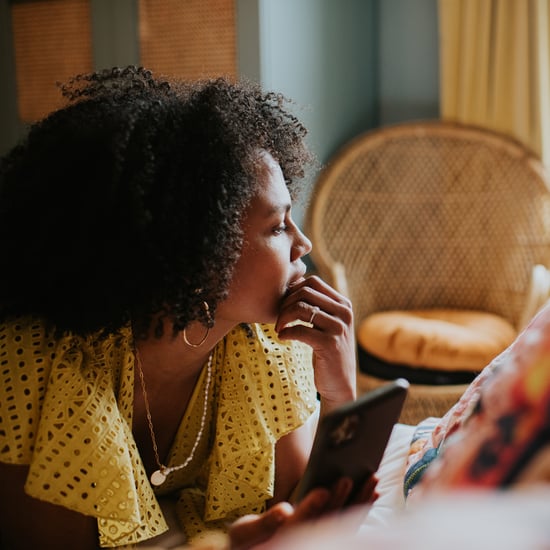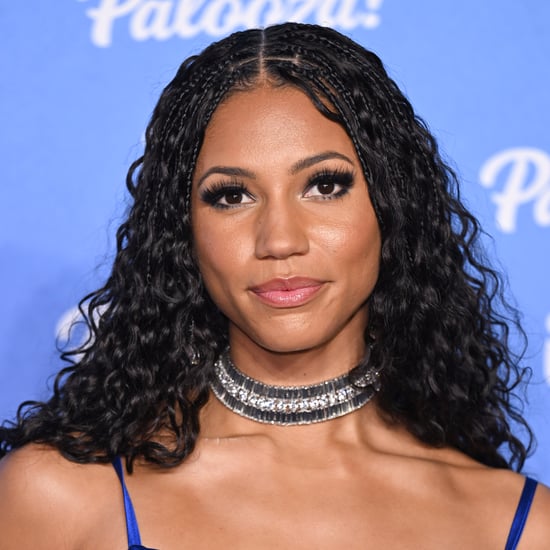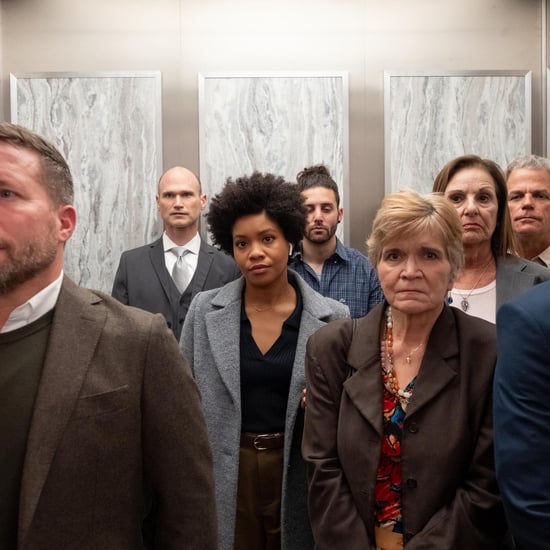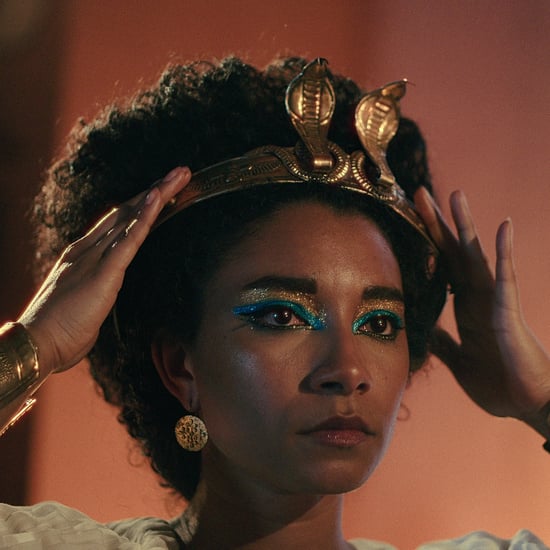Behind the Influencer Pay Gap in the Beauty Industry
Let's Talk About the Influencer Pay Gap in the Beauty Industry
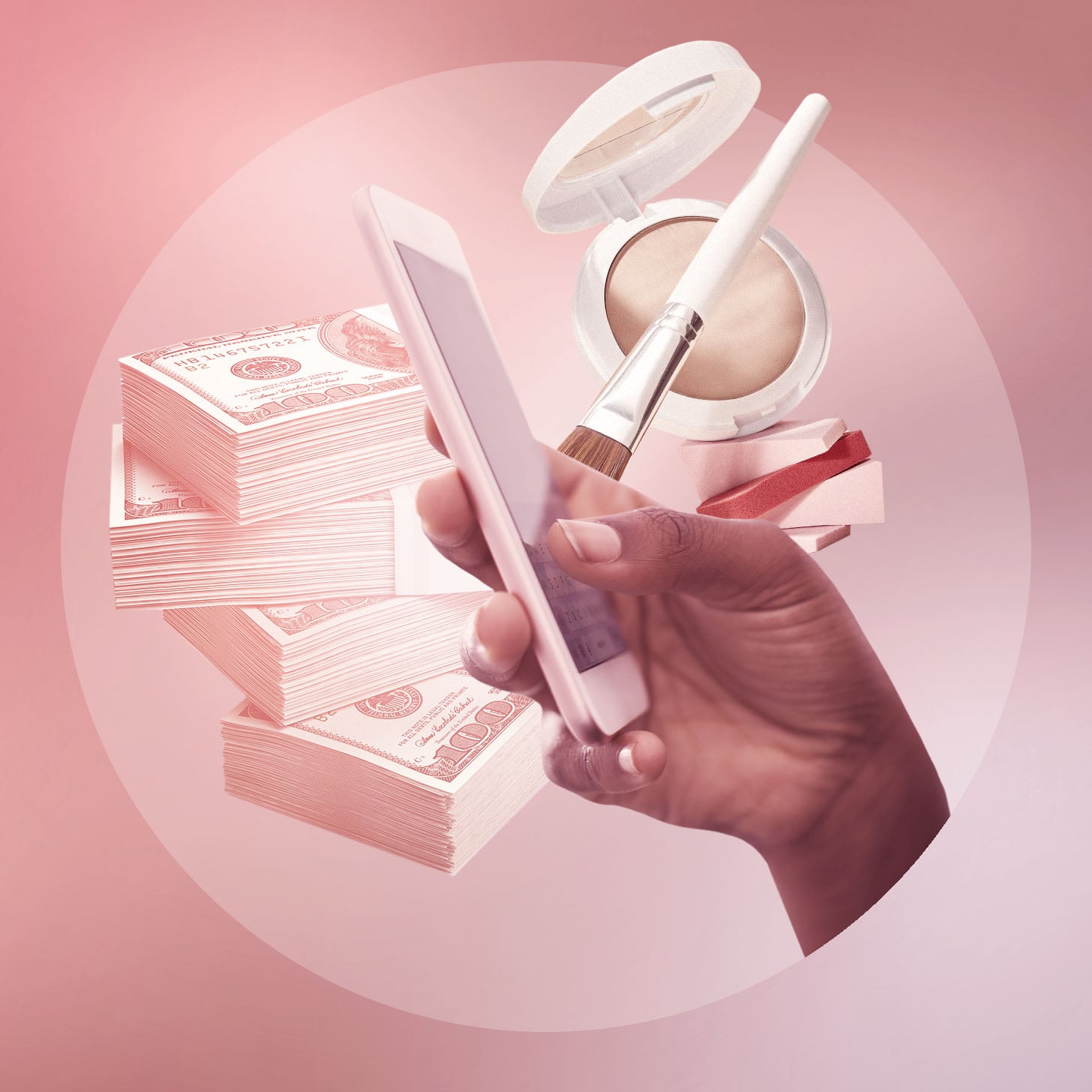
Three years ago, Cynthia Victor was a junior in college, going to class virtually and living life like any ordinary student. Now, the Sri Lankan Tamil is a beauty influencer, known as Shawtysin to her 1.7 million followers on TikTok, striking brand deals, making a name for herself as a content creator — so much so that she made the decision to commit to it full-time this year — and more recently, being invited to attend brand trips. The latest: an all-expenses-paid excursion to Turks & Caicos with Tarte Cosmetics.
It's this trip that inadvertently catapulted Victor into the spotlight. After filming a room tour, some of her followers couldn't help but point out in the comments how much smaller her room was compared with another influencer, who is white and has 18.2 million followers. "They out me on the smallest room but I'm just happy to be here," Victor captioned the video, which racked up nearly 362,000 views. (A request for comment from Tarte was never returned.)
It's not just about room size — influencer brand trips, across all industries, have been called out for being alarmingly white. Fashion's favourite whistleblower Diet Prada has repeatedly put brands on blast for their nearly all-white influencer trips or campaigns, like Boss and Etro. Alicia Tenise, a Black lifestyle blogger based in Los Angeles, highlighted the problem on Twitter, "screenshotting every press trip I've seen over the last month and the lack of diversity is so upsetting but not surprising."
One could argue that the subtext here is that influencers of colour aren't treated the same as their white counterparts. It's not a huge leap, then, to make the conclusion that the lack of inclusivity might reflect an undercurrent of racism at play, which not only leads to fewer opportunities for BIPOC content creators, but also lower rates. It's worth noting that none of the influencers were paid to attend the Tarte trip referenced above, according to Glossy — neither to Turks & Caicos nor Dubai — though Victor has been paid to attend one trip in the past. Influencers agree that those paid opportunities are few and far between.
Typically, there's a set of agreed-upon deliverables in exchange for attending a trip, and because everyone's contract differs, this is where a gap might exist among influencers — one might be required to fulfil a more labour-intensive deliverable, like a video, while another might only have to post a single Instagram Story.
"The pay gap exists in the real world, so why wouldn't it exist in the influencer industry?" Victor says. "The influencer industry in beauty is dominated by white women, so white women have the upper hand in it. In my community, even to this day, I am the only South Asian, Sri Lankan woman on TikTok [with this number of followers]. And I'm saying this not in a boasting way, but in a sad way . . . it's just so much harder for us to make it."
Her journey to social media stardom was fast and furious. After moving back home to New Jersey during the pandemic, she created an account on TikTok — a platform still in its nascent stage at the time — and launched a series in which she matched her makeup to random items in the house, like a Jenga block. She ended up going viral, quickly amassing thousands of followers. Within a couple of months, brands started reaching out (her first brand deal with L.A. Girl was about six months in). More opportunities came her way when she joined Sephora Squad, which propelled her to the next level.
"I'm the opposite of a 'beautiful South Asian woman,' who is skinny and tall with long black hair and light skin — I'm bigger, shorter, darker skinned. Nobody looked my way, and I was very insecure, but makeup was a way to get attention — it made me realise, OK, I can be beautiful," Victor says. "But it's bigger than me: People who look like me finally feel seen."
Going viral is something all influencers hope to achieve, and while it happened to Victor earlier on in her social media career, it didn't exempt her from what everyone experiences from the outset: the anxiety and uncertainty that plagues any aspiring content creator struggling to figure out how to determine rates. There's no guidebook. There's no one telling you how much you or your content is worth. "Literally nobody I knew did this," Victor says. "And if I had someone to ask, 'How much do you get paid for this?', then we [could have grown] together."
Denyse Jeter, a Chicago-based lifestyle influencer, felt the same, going into the industry "very clueless" when brands started reaching out a few years after she started posting consistently. So, she turned to the internet, and googled, What's a good rate? The results were all over the place.
"The first few were just a lot of gifting collabs. There are some brands that are more upfront about a gifted or a paid partnership, but a lot of others are just not transparent," says Jeter, who now asks interested brands what their budget is — a negotiating tactic she learned after experiencing a situation in which a company refused to meet her rate despite having a bigger budget. "I've been told before that [a brand] didn't want to pay my rate because of my follower count, which I completely understand, because someone with a bigger following and better engagement is going to reach a wider audience. But when there's no reasoning behind it and you see someone else with the same follower count who's getting paid that amount, you start to wonder, Is it really about follower count or is it about how I look?"
For so many BIPOC content creators this is the question that burns in the back of their minds, that creeps to the forefront when they suspect unfair treatment. It's the reason why, Jeter says, so many feel the pressure to look a certain way — to get their hair done, to look more presentable — on TikTok, so "they can get more exposure and have more likability."
"I think that it's kind of insane because I'm not paying extra to get myself done to make content I want to make for whoever wants to see it," Jeter says. "But that's the reality here."
That pressure runs even deeper in the beauty industry, where so much of the content is contingent on appearances. Fatima Peabody says she's lucky to have a tight-knit group of friends with whom she can discuss rates, but it's hard to ignore the difference in numbers and in opportunities granted to those who are white. "I hate to say it, but it does happen," says the Dallas-based beauty influencer who's been creating content for over a decade. "Brands want to market to whoever looks best to them, whoever is going to get the most attention, and sometimes that doesn't look like us, at least in their eyes. I've accepted that. It's not something that I can control myself, but I'm aware of it."
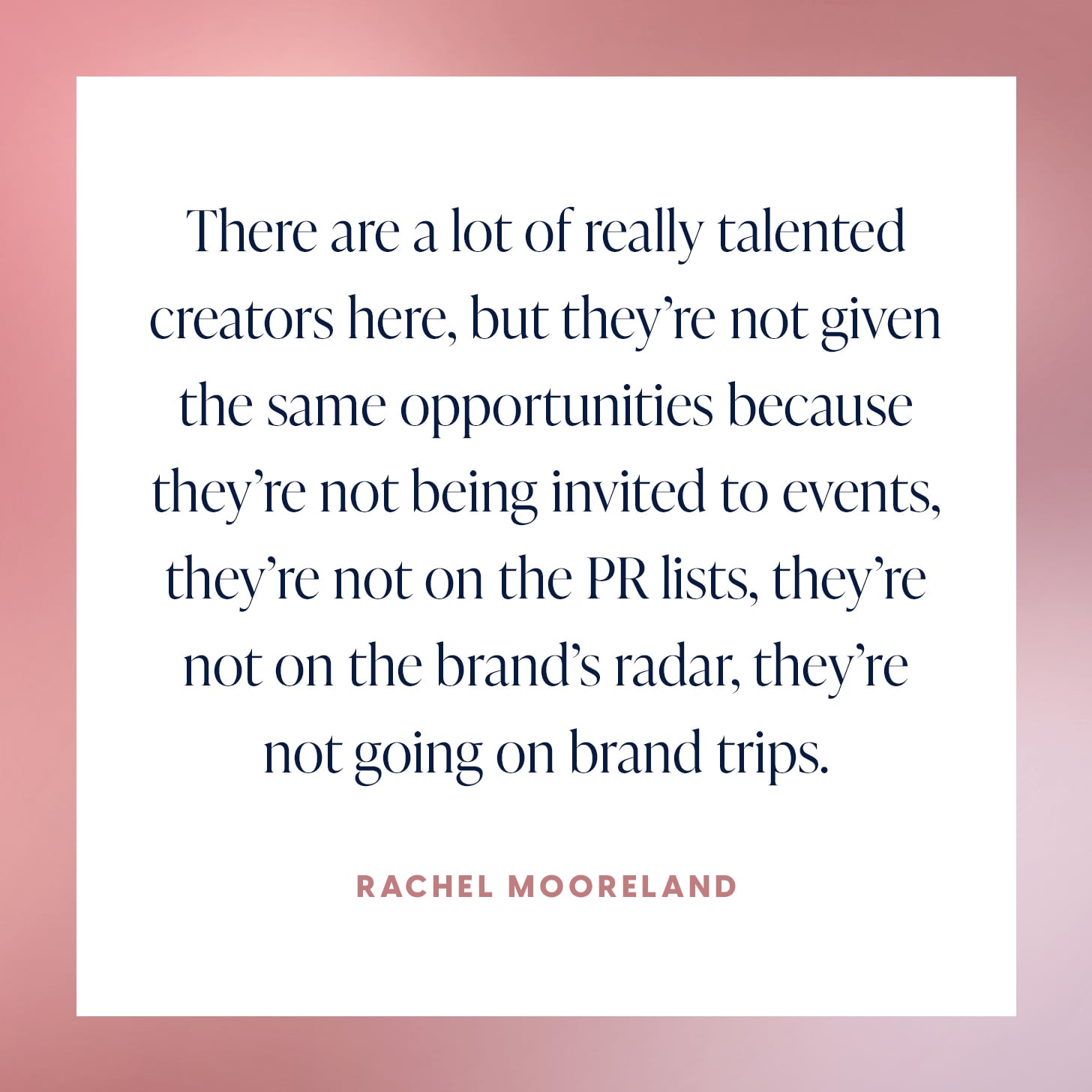
Rachel Mooreland calls it an opportunity gap — it's this discrepancy that needs to be addressed first. "There are a lot of really talented creators here, but they're not given the same opportunities because they're not being invited to events, they're not on the PR lists, they're not on the brand's radar, they're not going on brand trips," says the fashion and beauty influencer, who has taken it upon herself to carve out a space for Chicago-based Black and brown creators by hosting Instagrammable events sponsored by Black-owned businesses in the hopes to foster a community. "This industry lends itself more to white influencers, so while there's definitely a pay gap, a lot of it comes down to a lack of exposure. If you get one opportunity with a brand, it can turn into a continued job, but you need the opportunity in the first place."
She recognises how lucky she's been to be given opportunities in the six years she's been creating content, though she distinctly remembers being paid something like $50 for one of her early sponsored posts. It all changed for her in 2020 during the time when everyone was posting black squares on Instagram in solidarity with the Black Lives Matter movement. She was put on lists that declared "The Top 10 Black Creators To Work With," and all of a sudden, brands began reaching out, flooding her inbox and DMs with invites and potential collaborations.
"I was like, Wait a minute, do you really want to work with me or are you trying to check a box?," says Mooreland. She recalls events where she was one of the very few influencers of colour there, if not the only one. "There was one event with free makeup, but I couldn't wear anything outside of the lipsticks, because the shades weren't dark enough for my skin tone. So I'm here, but is this really for me? Why was I invited? It feels like tokenism."
Christine Le, for one, has also experienced it, feeling like the "token Asian person or person of colour for events, trips, and campaigns."
But for Simi Moonlight, a New York-based content creator with nearly 300,000 followers, she says she's never been invited to attend a beauty-specific brand trip and has been discriminated against "more than I can count, unfortunately — it's what comes with being Black and othered." While she gets paid "pretty well," thanks to her hardworking team, she says learning about white influencers' rates was, nevertheless, shocking. "Some were getting paid way more for way less and with way fewer followers and engagement," she says.
It can be discourageing, especially for those just starting out, even in spite of groups designed to help demystify rates and create transparency like the Fuck You Pay Me platform, anonymous Instagram pages like #InfluencerPayGap, or the Clara app. Factor in the multitude of variables — an ever-changing algorithm, mercurial engagement rates, the type of social media platform or format (a static in-feed post or video, for example, versus something more ephemeral like an Instagram Story), how big (or small) the budget is — and rates can feel like they're written in the sand.
When asked, influencers graciously shared their rates for this story anonymously. One, who has about 75k followers on Instagram, charges around $5,000 for one Reel, which comes with a set of Stories — three frames — for 30 days of organic usage, with additional charges for exclusivity. Another, who has 32k followers on TikTok, charges $500 for a video, with an additional $300 for 30 days of usage. An influencer with 62k followers on Instagram charges $500 for a Reel, though she admits it's low. That's the same rate for another, who has 2k followers, for a Reel or TikTok (though if it's a well-established company asking for whitelisting in Reels, she charges $2,000).
For another who has 28k followers, she asks for $3,000 to $4,000 for an Instagram carousel, and $1,500 to $3,000 for a Reel. An influencer with a million followers initially charged $500, but now her rate runs upward of $20,000 for one TikTok, thanks to an agency that advocates for higher pay on her behalf.
This world is still evolving — a fact that Taylor Schear, founder and CEO of Sheer Media, an agency that specialises in social strategy and influencer marketing, stresses. She believes that with every year that passes, there's a greater degree of standardisation in terms of how much brands are willing to pay influencers.
There is so much nuance around why the influencer pay gap exists, much of which can be traced back to systemic racism. Put simply, with limited representation comes limited opportunity.
"With that said, you're still going to find influencers who charge way more or way less than another of their size because they can all set their pricing, just like any freelancer or creative would," she says. "On the brand side, for us, rates are based solely on standardised metrics of followers and engagement rates. And of course, what the goal is — if it's a brand awareness campaign, a brand might want an influencer who puts time and energy into every photo or video, even if they only have 10,000 followers, rather than someone who has 100,000 followers but doesn't have as high quality of content." (Brands also look at sales metrics like click-through rates, sales conversion rates, and impression volume, no matter who they're working with.)
Nya-Gabriella Parchment, VP of brand partnerships and marketing at influencer talent agency DBA, first saw how substantial the gap was years ago when she was at an agency. The approach to influencer negotiations then was to ask creators for their rates first (versus sharing brand budgets), and she immediately saw the difference in rates between creators of colour and white influencers. But she's set on changing that.
"When bringing on new talent at DBA, we often find that the rates they set for themselves are lower than the industry standard, and as managers, we advocate for our talent and raise those rates, which has resulted in our Black talent's business growing three to five times," says Parchment, who launched a mentorship program to give creators access to industry best practices and tools to help build their business (contract terms, rate negotiations, how to pitch, and more). "There is so much nuance around why the influencer pay gap exists, much of which can be traced back to systemic racism. Put simply, with limited representation comes limited opportunity. Creators of colour are often left out of the conversation, resulting in an unfavourable compromise on their end, especially as it relates to pay."
The ugly side of content creation — and social media writ large — is comparing yourself to others. And almost everyone had a story to share or an anecdote they heard about someone else: an influencer was paid thousands of dollars more than another for showing up at an event, a friend was on a reality show and she charges $35,000 for one sponsored post, one influencer charges $300,000 for a single TikTok. They're all white.
So much of the onus to implement change falls squarely on the shoulders of businesses. It begins with diverse staffing at brands and social media marketing agencies who not only want to work with BIPOC content creators, but also offer inclusive products, along with PR companies that should be actively seeking out and updating their lists with up-and-comers, instead of relying on the same rotation of influencers of colour.
And similar to salaries, the only way to really eliminate any sort of ambiguity (or to put it plainly, know if you're being low-balled) is by sharing your numbers with others (although influencers should ensure that this doesn't violate the terms of their agreement with a given brand), even if those are really difficult conversations to have. The first step is to ask. Mina Im negotiates million-dollar campaigns for her corporate job, and she's able to flex that skill when it comes to her side hustle as a lifestyle influencer. Her approach is to always ask for more, to shoot for the moon. "At the end of the day I want to be paid correctly," she says. "I don't want to be taken advantage of, because I produce good, quality work."
Mooreland has been in a situation in which her rates were too high and she lost the deal. "But guess what? I don't feel gross about doing a ton of work for less than my value," she says. "Because our opportunities are more limited, we take less than what we deserve, but I guarantee someone else might ask for more and they might get it. And if you don't ask, you're going to get the lower amount. Ask for what you're worth."
